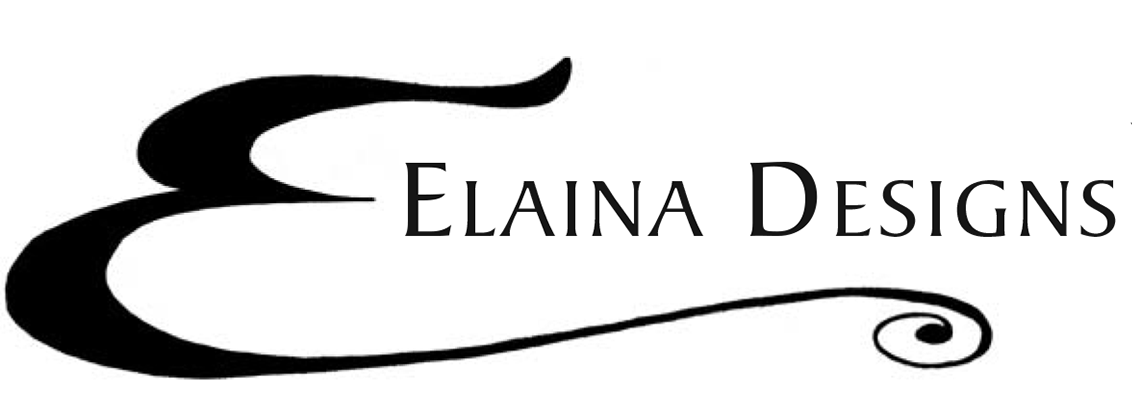Jewel Street Interview with Lainey Papageorge
Originally posted on Dec 08, 2017 by Jewel Street
One does not ask to be born an artist, but Lainey Papageorge couldn’t be happier that she was one of the chosen ones. Before finding gems in her mid-twenties, Lainey was an athlete, a swimmer, a choreographer and a modern dancer. But after she picked up a jeweler’s torch for the first time and hammered her first piece of metal, her love for the industry was instantly ignited.
With a jewelry career now spanning across 43 years, Lainey’s utterly fascinating journey has been full to the brim of twists and turns. We chat with her about what it was like growing up with learning difficulties, how a special bespoke commission brought her and her husband together and some of the incredible remote locations she’s designed jewelry in.
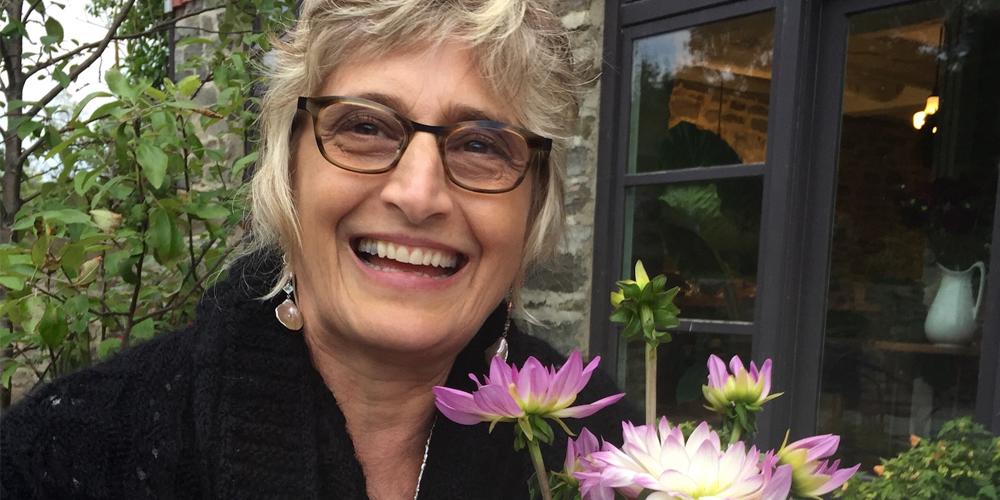
“I had been born with learning disabilities that at that time had no name except the notation, ‘possible retardation from oxygen deprivation at birth.'”
When did you fall in love with jewelry?
“I fell in love with the concept of beauty captured in tiny colored stones aligned just so, while playing with my mother’s jewelry when she dressed to go out on Saturday night dates with my Papa. She had both costume and real jewelry, but even from an early age I could discern the real gems from the fake ones. I studied how each piece was made, how the stones were secured. Handling them was the one thing that never failed to calm my often-overstimulated brain. Savouring this inner calm led to a desire to spend time with stones of any kind. Mama was always happy when getting ready for her dates – trying on different dresses, asking my opinion about what went best with what? At age seven I believe she recognised my eye for color and valued my opinion. I felt I had an important talent and it anchored the concept that jewelry was a playful accessory that brought joy.”
Where did you grow up?
“As a native Atlantan, we lived next to a special old-growth forest preserve named Fernbank Forest, not far from downtown Atlanta, Georgia, USA. On weekdays, my parents were at work and my older sister was already in school, resulting in me being left with a taciturn maid who did not understand my peculiar nature. To stay out of her way, I spent whole days exploring the woods and creek that ran through our backyard. Solitude in nature turned out to be an important commodity in developing a rich inner life, because I also experienced great frustration trying to learn what appeared to come easily to other children. I had been born with learning disabilities that at that time had no name except the notation, “possible retardation from oxygen deprivation at birth.” Yet when I entered the creek, I was entering another, finer universe that merged with my own splendid creative mind. I gathered rocks, recognising shapes and patterns as I arranged them on the sandy beach. Whole days alone spent listening to the stones focused my visual discernment and empowered my artist’s inner voice. I could not know that I was polishing the lens for my future profession, yet I recognise the same sensation each time I begin a jewelry design.”

Who has been your biggest influence?
“My father had a huge influence on my future profession, and I was fortunate to enjoy his serene wisdom until he passed away four years ago, at the age of 101. He was a civil engineer who designed large airplane body parts. He had a collection of steel tools and anvils in our basement, and on weekends I often set up play nearby with my 13 cats who also shared his basement workshop. I adored my Papa, and I can still feel his complete concentration as he silently worked, his countenance calm and focus as he appeared to forget my presence.”
“With every extra dollar I earned from teaching movement education, I invested in a pair of pliers or a special file, tools I still use today.”
How did you get into the jewelry industry?
“The first time I picked up a jeweler’s torch aged 23, I was initiated into a life-long love affair that began after I had finished college and was teaching Physical Education at a private school. I hit my first hammer and anvil in 1974 at the home of a girlfriend whose hobby was jewelry making. Over a 2-week stay, I became besotted directing fire with her tiny torch and hammering metal on metal. Upon returning to my day job, it was clear that a new avenue of expression had caught fire in me.
In 1974 there were no obvious places in Atlanta to learn how to make jewelry, but I finally found a bench jeweler at a little retail shop in a nearby town who was willing to let me work beside him for a few hours on Saturdays, in exchange for doing his polishing and shop clean up. With every extra dollar I earned from teaching movement education, I invested in a pair of pliers or a special file, tools I still use today.
After this short apprenticeship I mostly taught myself through trial and error. Years later I found my true artistic mentor in an interior designer called Blanche Reeves, who had a brilliant eye and a keen sense for what made good art. In 1980, I made an appointment to show my Alaska inspired jewelry to Blanche, owner of the first gallery in the USA to specialise in fine, handmade crafts. With my dozen pieces spread on her desk, Blanche put her feet up beside them, leaned back in her Swedish designer chair, and began to speak in her gravelly voice, not to me but to the ceiling, “Lainey, how would you like to be my first Artist in Residence at The Signature Shop?” Her recognition of my talent was a pivotal moment as she became my first real mentor for design and proportion, offering a stringent critique on my work, while introducing me to her brilliant patrons.”
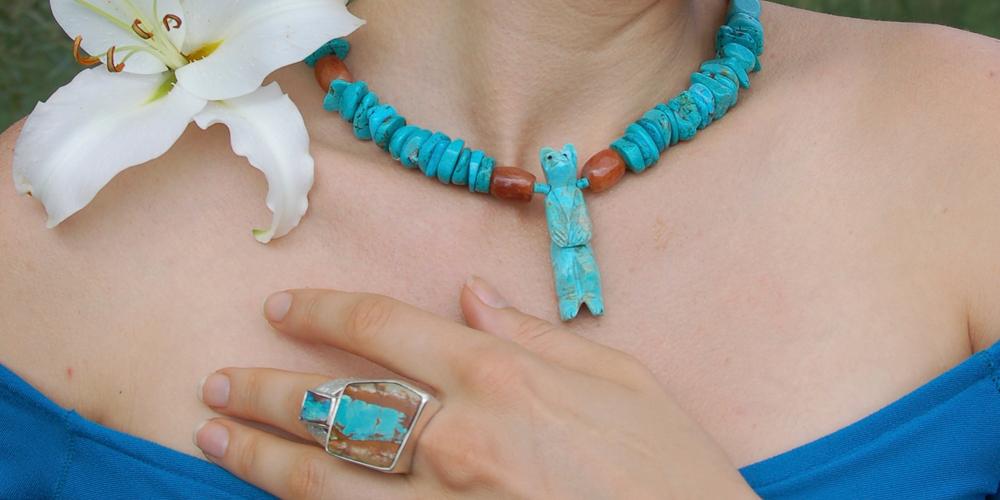
“I flew north with two suitcases, two cats, two hundred dollars, and no car or furniture to forge a new identity”
What inspired you to start your own jewelry line?
“I established my first jewelry shop after I moved to Seattle in 1975 with my then doctor husband who was doing his medical residency. Separated from any known clientele or support systems, I fabricated simple jewelry for women and men in Seattle who began to purchase my jewelry. I also did repairs and restringing to make ends meet. I’m good with people and found they could appreciate the intense concentration I devoted to my craft.
In 1976, having explored the glorious wonders of the Pacific northwest, I felt ready and able to push farther north on my own. I left my miserable marriage, crated my tools on a slow barge up the Inside Passage to Skagway, Alaska and closed my Seattle shop. I flew north with two suitcases, two cats, two hundred dollars, and no car or furniture to forge a new identity, hoping to articulate an artistic language worthy of expression. I was driven to create art jewelry more than the baubles that had a short shelf life in the fashion industry. I was truly alone for the first time in my entire life in Skagway, Alaska, a tiny town of 600 permanent residents that became a tourist haven during the summer months.

“Tourists were buying my jewelry as fast as I could complete it.”
I struggled to develop my own style, teaching myself to work in gold, travelling to the gold fields in the Yukon Territory to buy native placer gold nuggets shaped like the creek stones from my childhood. I sawed craggy fir trees in gold, soldered against gold nugget mountain ridges and rimmed lakes, crested by rising opal moons and diamond suns that became tiny jewelled landscapes. My artistic voice was arising and I was engaged and in love with a place and its community. I had found a slice of paradise as the stones and metal contained in my first jewelry line began to vibrate under my touch.
“I had never felt so divinely engaged in anything before as in making my first real line of jewelry.”
The Alaskan wilderness was vast and strange, a total inspiration as I observed the rich natural vistas as day barely morphed into night during the long summer sun. I worked long 12-16-hour workdays, totally immersed in the process of creation and selling. When I made mistakes, rather than scrapping the piece, I managed to make what was supposed to have been a ring, work from a different angle to become a pendant or a pair of asymmetrical earrings. Over the course of that first summer in 1976, while making jewelry for the cruise ship trade, I realised that tourists were buying my jewelry as fast as I could complete it. I developed a style unlike anything I had ever seen. Over the long dark winter, I stockpiled my creations and named them. In 1976-1977 I developed my first line of jewelry in an old World War II Quonset hut, my jeweler’s bench positioned beside a barrel stove to keep me warm while wind and snow howled through the narrow valley. I had never felt so divinely engaged in anything before as in making my first real line of jewelry.”
What are your core brand values?
“The Earth is my inspiration and my teacher; she is also my responsibility. I purchase consciously mined stones and recycle old jewelry whenever possible, incorporating only minerals and gems that are formed in the earth or water. Each piece is unique, with the values of hand craftsmanship aided by sophisticated technology. The jewelry I make is intended to create a harmony of colour and vibration that is not only uplifting visually, but which may offer a subtle stabilising benefit to the wearer. I place a high value on integrity with my vendors, with my goldsmiths and with my clients. I also always honour the stones.”
“The Earth is my inspiration and my teacher; she is also my responsibility.”
Where do you do your best work?
“I can create jewelry anywhere on earth so long as I am alone for an extended period of time with the gems and minerals at my fingertips. When the union of light and matter fuse, I become one with the elements, the stones my channel.
I employ two different approaches to jewelry design, and it seems they draw from separate sides of my brain and require different environments in order to arise. One location is in the serenity of my Atlanta or New York studios, working one on one with a client. I study their faces, their hands, the way light plays between their eyes, skin and hair. I offer several design options and they get to choose. The other avenue is when I create a jewelry series made to sell to clients whom I will never know, such as the items on my JewelStreet boutique. It usually requires a remote location. My best work arises from a quiet mind, not a busy one, a mind attuned to the wonders abundant in nature. I raised three children primarily as a single mom so I had to develop moments of solitude for design time when I could, often at night.”
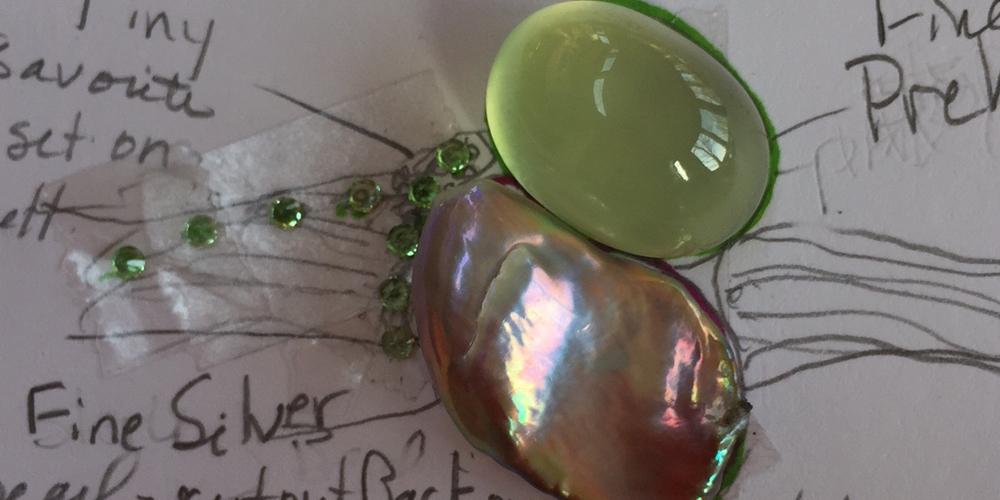
Why did you switch from making jewelry to solely designing it?
“Life has its way with one. After repeated injuries then illness, I was forced to stop hammering and using flux essential to the torch; I could no longer make my own designs. Rather than end my love affair with jewelry, in 1991 I became strictly a designer. During the 1990’s at Illumina, the Atlanta high-end jewelry gallery that I began and ran for 12 years, I collaborated with many fine goldsmiths whose work I represented and sold. Together we created some outstanding pieces with outrageous gemstones.
I searched long and hard to find a primary master goldsmith who could execute my designs with love and skill, and found the perfect creative partner in Fareed Abdulky, a master goldsmith from Damascus. He is a wizard able to conjure up anything in gold, silver or platinum that I can come up with. We absolutely cherish working together at his New York workshop that is near my Ithaca home/design studio where I live six months out of each year.”
“Over the course of that particular bracelet commission, we fell madly in love and years later he asked me to marry him.”
Tell us about a commission you’re particularly proud of…
“I’m most proud of the designs I create that tell a person’s family story through jewelry. For example, a bereft mother came to me with an unusual request to create a diamond ring that she could always wear to keep her daughter nearby. We worked on the design over 9 months while the diamond was being formed from the carbon in her 20-year-old daughter’s ashes. It was sacred to work with this charged diamond, which turned out to be a most unusual shade of orange/gold. The mother adored her completed ring, and I can still feel that diamond between my fingertips.
But my all-time favorite jewelry story, and the one that I’m most proud of, occurred 11 years ago when I designed a man’s link bracelet for an old client of mine, David H. He came to me with a box of items his wife and mother had lovingly worn. I decided not to melt anything but to reconfigure the existing settings. My goldsmith flattened, then cut his deceased wife’s diamond and platinum wedding band (that I had designed for her a long time ago) and his 18kt wedding band into three sections, interspersed his mother’s bridal diamond, deconstructed his wife’s rare Muzo emerald earrings (that I had designed for her) into links for an unusual 18kt and platinum bracelet. It was an intricate piece that he wore and cherished until it was sadly lost. Over the course of that particular bracelet commission, we fell madly in love and years later he asked me to marry him. I gladly accepted. We appreciate our blessed union while every day I give thanks that my jewelry design brought this amazing man to me.”
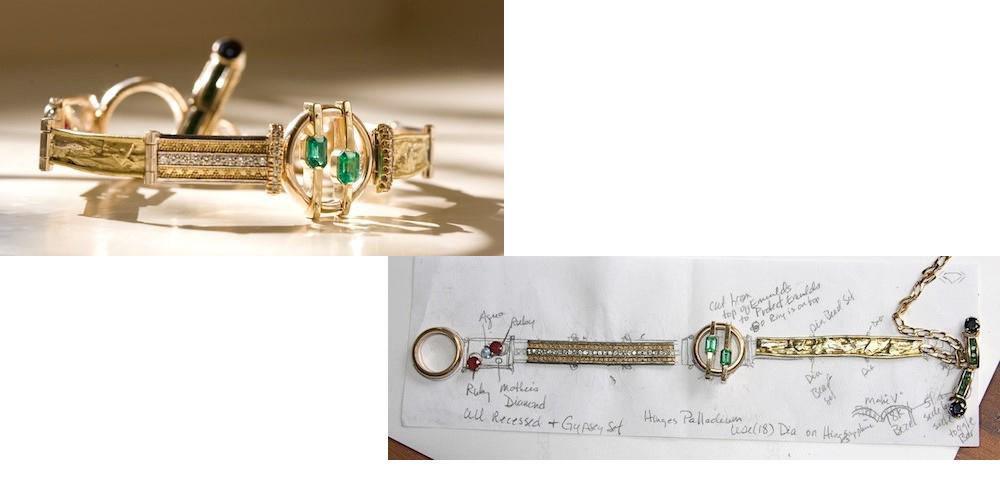
How do you source your materials?
“For 30 years I’ve collected most of my gems at the International Gem and Mineral show in Tucson, Arizona where I stay for about one week each year. I plan my annual budget around this trip because when gems and minerals are your only choice for palette colors, replenishing one’s supply is imperative. I always ask how the materials come to them and I place my trust in these people when they say that their sources are transparent and consciously mined and cut. One can never know for certain in the case of every gem that I own, but it is one reason I prefer to buy colored stones rather than diamonds for my work. When I do incorporate diamonds, they have usually been inherited or the client already owns them.”
How do you want someone to feel when they wear a piece of your jewelry?
“When I design a piece of jewelry, my desire is to make the wearer feel better than before they placed the item on their body. I always ask them to close their eyes and just try to ‘feel’ the piece on their body. This form of beauty is not only externally seen but internally sensed. Jewelry at its best is a delicate dance between light, color and movement. I want them to experience themselves as calmer, finer and recognisable as who they truly are from the inside out. If they can answer yes, “It feels good!”, then I am proud and confident that I have hit a home run.”
What has been the highest point of your career as a designer so far?
“Every new piece purchased and chosen by the owner to be frequently worn becomes a high mark towards which I always strive. Yet when I view my career from the bigger picture, the highest point has to be the museum Retrospective of my work mounted in 2014. The Curator/Director of the Museum of Contemporary Art of Georgia invited me to do a one woman show of my jewelry spanning 40 years of jewelry design. I was elated and intimidated, never imagining the amount of work this would require of me and their museum staff. There were 112 pieces chosen to be loaned back to the museum from clients all over the USA for a 3-month period.”
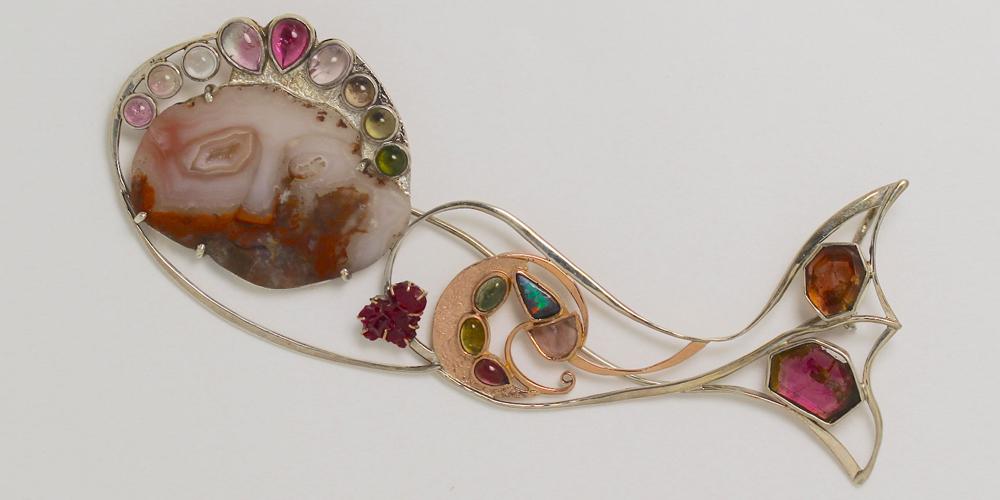
“Even after 43 years, each design begins with a fresh awareness and a stinging desire.”
You should be incredibly proud of your brand and what you have achieved to date. What drives you to continue designing jewelry?
“I love what I do and as long as my work is being purchased and cherished, I will continue working with this form of expression. Achieving resonance through my jewelry is what drives me to make each piece unique and comfortable to wear, while emitting its own harmony and subtle vibration through beauty and color. When I design jewelry, I experience resonance.
Even after 43 years, each design begins with a fresh awareness and a stinging desire. A desire to make something new, succinct and beautiful, each piece with its own resonance worthy enough to adorn and be of benefit to a human body.”
